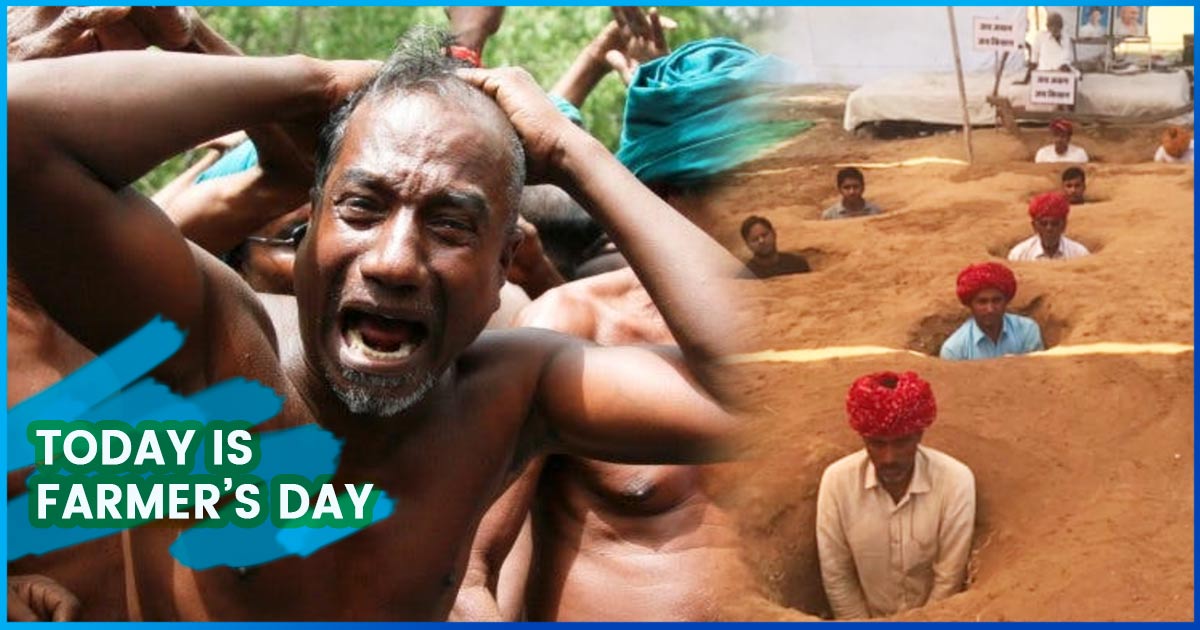
Farmer's Day: A Quick Look At The Farmers Protests This Year
23 Dec 2017 2:40 PM GMT
Editor : Ankit Sharma Sharma
Green tea Addict | A Tree Hugger | Born for Change
Kisan Diwas, also known as Farmer’s Day, is celebrated every year on 23 December on the birth anniversary of the fifth Prime Minister and Kisan leader, late Chaudhary Charan Singh. This day is also known as Chaudhary Charan Singh Jayanti.
Chaudhary Charan Singh led a very simple life despite being the Prime Minister of India. He served the country as Prime Minister for a very short tenure starting from 28th of July 1979 until 14th January 1980. He followed the famous slogan ‘Jai Jawan Jai Kisan’ given by the 2nd Prime Minister of India, Lal Bahadur Shastri. Chaudhary Charan Singh was an excellent writer and wrote several books on farmers and their problems.
Where it all started
He belonged to a farmer’s family, this was the reason he could relate himself to the issues of the farmers, and therefore, he did the best to support them.
In Budget 1979, he introduced several policies in favor of Indian farmers and designed it accomplish the needs of farmers in all respect. Because of his humbleness and compassion, he was known as the leaders of the Kisan (Farmers).
The Agricultural Produce Market Bill was introduced by him in the Assembly. It was meant for the safeguard of the farmers against the avarice of dealers.
That is why, 23 December, his birth anniversary, is celebrated as Kisan Diwas, or the Farmer’s Day.
How is it observed?
It is extensively celebrated in Uttar Pradesh (UP) where the government organizes many programs, seminars and discussions related to farmers of India and Divisional Agriculture Science at District and Block level. Officers of the Agricultural Department, agricultural scientists come to the villages and talk to the farmers, understand their issues and provide them with solutions and information about the modern agriculture techniques and different types of insurance schemes to protect their cultivation.
The scientists share a lot of information on how the farmers can avoid the circumstances that can lead to less production of crops or a spoilt production of crops.
There are around 26 Agricultural Knowledge Centres and 31 Agriculture Science Centres in Uttar Pradesh, and they all celebrate this day with immense enthusiasm. Their organizations not only dedicate this day to commemorate the birthday of one of the former Indian Prime Ministers but also to help the farmers in the state.
Through the years, the government has developed a lot of offline as well as online helpline services for the farmers.
Despite all these efforts, every year many farmers commit suicide or protest. Through the years, there have been a lot of protests by the farmers.
Also Read: Why Farmers are protesting in our country?
Many Protests
1. June 2017
Madhya Pradesh witnessed an outcry from the farmers in this year’s June who were protesting for fair price and loan waiver. In a bid to force the Government to set the price of the milk at Rs 50 per liter, they were staging a protest by throwing fruits, vegetables, and milk. The protest soon took a violent turn when six bikes and two shops were set on fire. The security forces to control the situation opened fire on the agitators leading to the death of five farmers. CM Bhupendra Singh dismissed the fact that the police opened fire. He said some anti-social people incited the violence that led to the killing.
2. July 2017
The worst drought in 144 years hit Tamil Nadu in 2016-17 which resulted in many farmers committing suicide. The relief funds were not distributed evenly, and they were not abandoning the loans of the farmers they got from the cooperative banks.
That is when the Tamil Nadu farmers started to protest against the central Government in Jantar Mantar, New Delhi.
Demands of the Farmers:
• Demand for better prices of their produce – as they are not getting the minimum support price (MSP).
• The absence of an effective buying mechanism has compelled farmers to go for a distress sale. At grain Mandis, the traders were buying at a reduced price.
• Before coming to power, BJP had promised to implement the recommendations of the Swaminathan Commission report, especially related to MSP, but it was done.
• Post-demonetisation, the traders at Mandi, shave been exploiting farmers by delaying their payments against the sale of crops on a pretext of delayed payments by cheques. A rise in farmer suicides in various states, especially by marginal farmers have irked the community.
• The demand for waiving of farmers’ loans is central to their protest.
3. September 2017
Another protest happened in Rajasthan where the farmers were demanding waiver of the loans amounting to Rs. 49, 500 crores.
The Rajasthan government announced Rs 20,000 crore farm-loan waiver after a two-week-long protest that saw thousands of farmers pouring in from across the state to narrate stories of agricultural distress.
The government also agreed to other demands of farmers including the purchase of crops at minimum support price (MSP), increasing farmers’ pension from Rs 500 to Rs 5,000, removing the ban on the sale of cattle imposed by the state government and implementation of the Swaminathan commission recommendations.
3. October 2017
October 2: Hundreds of farmers in Rajasthan had ‘buried’ themselves in the ground to enable talks between them and the Vasundhara Raje-led government. The Jaipur Development Authority (JDA) had been acquiring agricultural land, allegedly at very low rates, for a housing project which led hundreds of farmers to protest. After nearly a month of deadlock, the talks between representatives of the Neendar Bachao Yuva Kisan Sangharsh Samiti and the government ended the farmers’ protest on October 30.
4. December 2017
Yashwant Sinha raised his voice for the farmers in Maharashtra where the suicide rate of farmers was on the increase.
Following were the demands of the farmers:
• Compensation to cotton farmers for losses incurred due to pink bollworm infestation.
• Action against companies manufacturing “bogus” bio-technologically modified seeds
• 100 percent payout for crop losses to moong, urad and soybean farmers, have been accepted.
• Bank officials and administration execute loan waivers by personally visiting gram panchayats.
• Uninterrupted power supply to agricultural pump sets, removal of “unjust” conditions from the gold mortgage waiver scheme of the government for farmers, and purchase of all farm produce at MSP by NAFED (National Agricultural Cooperative Marketing Federation of India).
In the end, he spoke to the Chief Minister and was promised that now, no farmer will commit suicide.
 All section
All section













